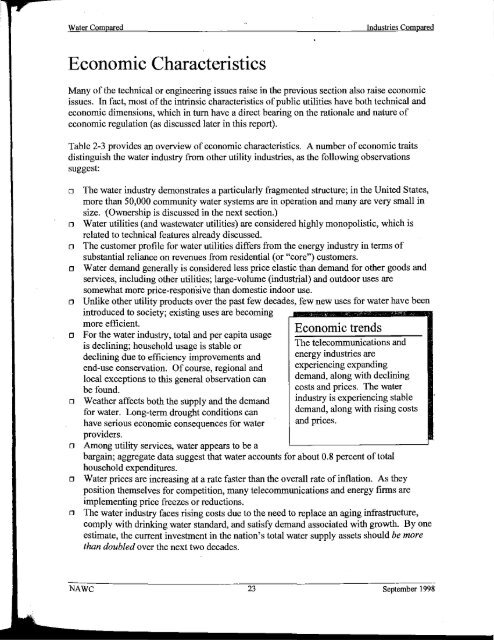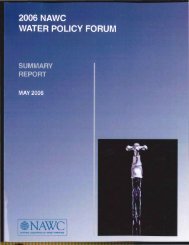BEECHER - NAWC
BEECHER - NAWC
BEECHER - NAWC
Create successful ePaper yourself
Turn your PDF publications into a flip-book with our unique Google optimized e-Paper software.
Water ComparedIndustries ComparedEconomic CharacteristicsMany of the technical or engineering issues raise in the previous section also raise economicissues. In fact, most of the intrinsic characteristics of public utilities have both technical andeconomic dimensions, which in turn have a direct bearing on the rationale and nature ofeconomic regulation (as discussed later in this report).Table 2-3 provides an overview of economic characteristics. A number of economic traitsdistinguish the water industry from other utility industries, as the following observationssuggest:ooooooooooThe water industry demonstrates a particularly fragmented structure; in the United States,more than 50,000 community water systems are in operation and many are very small insize. (Ownership is discussed in the next section.)Water utilities (and wastewater utilities) are considered highly monopolistic, which isrelated to technical features already discussed.The customer profile for water utilities differs from the energy industry in terms ofsubstantial reliance on revenues from residential (or "core") customers.Water demand generally is considered less price elastic than demand for other goods andservices, including other utilities; large-volume (industrial) and outdoor uses aresomewhat more price-responsive than domestic indoor use.Unlike other utility products over the past few decades, few new uses for water have beenintroduced to society; existing uses are becomingmore efficient.For the water industry, total and per capita usageis declining; household usage is stable ordeclining due to efficiency improvements andend-use conservation. Of course, regional andlocal exceptions to this general observation canbe found.Weather affects both the supply and the demandfor water. Long-term drought conditions canhave serious economic consequences for waterproviders.Economic trendsThe telecommunications andenergy industries areexperiencing expandingdemand, along with decliningcosts and prices. The waterindustry is experiencing stabledemand, along with rising costsand prices.Among utility services, water appears to be abargain; aggregate data suggest that water accounts for about 0.8 percent of totalhousehold expenditures.Water prices are increasing at a rate faster than the overall rate of inflation. As theyposition themselves for competition, many telecommunications and energy firms areimplementing price freezes or reductions.The water industry faces rising costs due to the need to replace an aging infrastructure,comply with drinking water standard, and satisfy demand associated with growth. By oneestimate, the current investment in the nation's total water supply assets should be morethan doubled over the next two decades.<strong>NAWC</strong> 23 September 1998
















